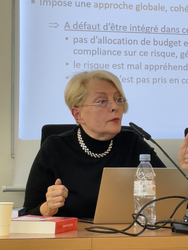📧 Risk mapping and Competition: the place and future of Compliance Law
pour lire cette présentation en français ↗️ cliquer sur le drapeau français

🌐follow Marie-Anne Frison-Roche on LinkedIn
🌐subscribe to the Newsletter MAFR Regulation, Compliance, Law
____
► Full Reference: M.-A. Frison-Roche, "Risk mapping and Competition: the place and future of Compliance Law", Newsletter MAFR Law, Compliance, Regulation, May 26, 2024
____
📧Read by freely subscribing other news of the Newsletter MAFR - Law, Compliance, Regulation
____
🧱Competition and compliance: challenge and future of risk mapping
Thank to the organizers of the conference held in French on competition and compliance, notably about the risk mapping, on 24 May 2024, at the Centre de droit européen - Université Paris-Panthéon-Assas, with the support of Larcier-Intersentia, for asking me to give the concluding lecture.
Thanks to the very high quality of the speakers, Fabrice Picod, Frederic Puel, Pierre de Gouville, Gaëlle Hardy, Alix Voglimacci, Marie-Pascale Heusse and Christophe Corlouer, I was able to draw some conclusions, in particular from the concrete experiences of the risk mapping methods chosen and experienced by firms.
____
📧read the article published on 25 May 2024 on this topic in the Newsletter MAFR - Law, Compliance, Regulation ⤵️
On 24 May 2024, I gave the concluding speech of the conference: On 24 May 2024, I gave the concluding summary of the conference: Concurrence : les enjeux de la compliance. Programme de conformité : le Document-cadre de l'Autorité de la concurrence. Retour d'expérience pratiques deux ans après (("Competition: the challenges of Compliance. Compliance programs: the French Competition Authority's Framework. Practical feedback two years after").
The event was held at the Centre de droit européen - Université Paris-Panthéon-Assas (thanks to Fabrice Picod), with the support of the publisher Larcier-Intersentia (thanks to Nicolas Cassart).
It consisted of two round-table discussions designed and moderated by Frederic Puel and Pierre de Gouville, partners at Fidal Paris.
🧮read the complete program of this manifestation
Academics, lawyers, and in-house counsel from enterprises have reported on how the French Competition Authority Framework on Compliance programs of 22 May 2022 has helped them to better map their risks.
It was very instructive!
Many thanks to all those who spoke and discussed these issues : Fabrice Picod, professor at the Panthéon-Assas université , director of the Centre de droit européen (CDE), Frederic Puel, partner of Fidal, Pierre de Gouville, partner of Fidal, Alix Voglimacci, egal and compliance director of PepsiCo France, Gaëlle Hardy, professor at the Université des Antilles, and Marie-Pascale Heusse, Head of Competition Law of the group BNP Paribas and Christophe Corlouer , chief compliance officer in the same banking group.
____
The first perspective is the legal basis for these guidelines, recommendations, incentives, methods, etc. Competition is often explicitly or implicitly the basis of many compliance measures, for example in the vigilance / corporate sustainability due diligence 2024 European directive.
The second perspective corresponds to the resources developed by the firm to establish and maintain these compliance programmes. Alongside risk mapping or for its efficiency, the enterprise organizes internal audits and investigations: these interviews conducted to establish the mapping, which humanise it, have many points of contact with audits and internal investigations and thus open up common difficulties, such as confidentiality.
The third perspective is the scope of this framework document, on which the scope of the compliance programmes adopted by the enterprises themselves also largely depends, whether voluntarily in the case of Competition rles, or forcefully in the case of anti-money laundering, anti-corruption or vigilance/due diligences duty. This mix of voluntary and mandatory adoption makes it difficult to measure the scope of the programme when the firm's programme is global, as the Competition Authority framework document recommends.
The fourth perspective concerns the legal subjects required to, or beneficiaries of the adoption of such Compliance programmes. This is certainly the enterprise concerned, solicited, or compelled by the Authority to act in order to fulfil its own mission to safeguard the competitive system for the future, "sustainability" being an essential concept in Compliance Law, which shifts the regimes of the rules from Ex Post to Ex Ante, including in Competition Law. This evolution from Ex Post to Ex Ante is truly a revolution.
The subjects of the law are also the 'stakeholders', a category that remains rather mysterious, since company law has itself been transformed by what is known as 'governance'. But technically, this gives rise to rights to information and rights of recourse, notably before courts. These technical issues, with their essential procedural implications, are currently before the courts. As a result, even when the legal discussion comes to the risk mapping process, no-one really seems to be a "third party" any more ....
This raises the question of the secrets and recipients of risk mapping: can risk maps, designed as a tool for managers, designed as a means of preserving systems by the Authority, be also designed for the people concerned as a means of action in a more general accountability perspective, since it indicates risks? The courts are also beginning to be questioned about that.
____
During this conclusion, which was based on the very pertinent contributions and comments of each speaker, I continued my reflections in each of these 4 directions.
This subject is at a crossroads: on the one hand, it deals with risk mapping, a major tool in Compliance Law, and on the other, it brings Competition Law and Compliance Law closer together.
These cross-fertilisations will increase, but they will also cause clashes because, to take just one example, Vigilance legal obligation, often translated in contracts, requires collaborative structures which must be coordinated with the prohibition of cartels, while the contractualisation of Compliance, a major phenomenon, may constitute an abuse of a dominant position.
____
Read also:
comments are disabled for this article